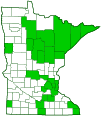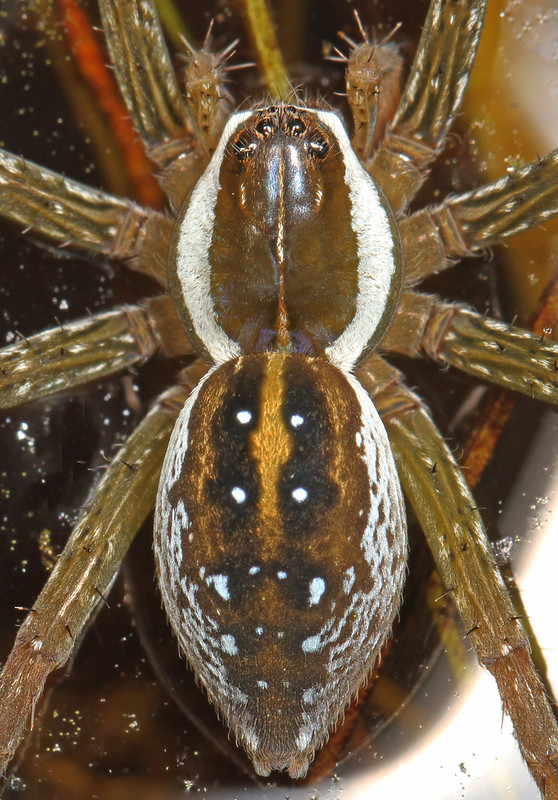six-spotted fishing spider
(Dolomedes triton)
Conservation • Description • Habitat • Biology • Distribution • Taxonomy
|
|
||||||||||||||
Description |
Six-spotted fishing spider is a large, robust, nursery web spider. It is one of the largest spiders encountered in Minnesota. The adult female body is dark brown with light markings and ⅝″ to ¾″ long with a legspan of 2″ to 3″. The front part of the body (cephalothorax) is about the same size as the rear part (abdomen). The covering (carapace) of the cephalothorax is dark gray to brown or greenish-brown with a bold, silvery-white to yellow stripe along each side. There is often a narrow pale center (middorsal) line and two shorter lateral lines that form a poorly developed trident shape. The abdomen is dark gray to brown, rounded in the front, widest in the middle, and tapers toward the rear. There is a broad white stripe running down each side and two rows of six small white spots on the upper (dorsal) surface. The spots are usually prominent, sometimes barely discernible. The underside (sternum) is paler. There are six large black spots between the leg bases. This is the feature that gives the spider its common name. The legs are long, thin and dark brown with thin, pale, longitudinal stripes. They are not horizontally banded. They are covered with hairs and have long black spines. The last leg segment (tarsus) has 3 claws, but these are not visible without magnification. The male is similar to the female but only about half the size. |
Size |
Female Body Length: ⅝″ to ¾″ Male Body Length: ⅜″ to ½″ Legspan: 2″ to 3″ |
Web |
| No web |
Similar Species |
Dark fishing spider (Dolomedes tenebrosus) is larger. It lacks the bold white stripes on the cephalothorax and abdomen. The legs appear horizontally banded, not longitudinally striped. |
Habitat |
Ponds, lakes, swamps, slow-moving streams |
Biology |
Season |
|
Behavior |
Six-spotted fishing spider does not produce a web to catch prey. The female produces a nursery web for its young. It is active during the day. It floats, and can run across the water surface like a water strider. When hunting, it perches on floating vegetation, detecting ripples and vibrations in the water with three of its front legs. It sometimes dives up to 7″ for prey or to escape a predator. It can create a bubble of air that allows it to stay under water for a half hour or more. |
Life Cycle |
Mating takes place between June and September. It may be the last act of the male, as the female is cannibalistic. After mating, the female produces a large egg sac, 5 ⁄16″ to ⅜″ in diameter, into which she begins laying eggs. She carries the egg sac around with her mouth as she wanders about. While carrying it, she cannot feed. When the eggs are about the hatch she attaches the sac between leaves in a shelter (nursery) which she has created. She then guards the nursery until the hatchlings disperse in about a week. Immature adults hibernate near water under stones, under loose bark, or other debris. Males mature and mate in the spring of the first year. Females mature in two years. |
Food |
Aquatic insects, small tadpoles, tiny fish, other insects that fall on the water surface |
Distribution |
||
|
Sources |
|
| 6/20/2025 | ||
Occurrence |
||
Widespread |
||
Taxonomy |
|
Class |
|
Order |
|
Suborder |
Araneomorphae (Typical Spiders) |
Infraorder |
Entelegynae |
Zoosection |
RTA clade (RTA Clade Spiders) |
Zoosubsection |
Oval calamistrum clade |
Superfamily |
Lycosoidea (wolf spiders and allies) |
Family |
Dolomedidae (fishing spiders) |
Genus |
|
Subordinate Taxa |
|
|
|
Synonyms |
|
|
|
Common Names |
|
six-spotted fishing spider sixspotted fishing spider |
|
Glossary
Carapace
The hard, upper (dorsal), shell-like covering (exoskeleton) of the body or at least the thorax of many arthropods and of turtles and tortoises. On crustaceans, it covers the cephalothorax. On spiders, the top of the cephalothorax made from a series of fused sclerites.
Cephalothorax
The front part of a spider’s body, composed of the head region and the thoracic area fused together. Eyes, legs, and antennae are attached to this part.
Tarsus
On insects, the last two to five subdivisions of the leg, attached to the tibia; the foot. On spiders, the last segment of the leg. Plural: tarsi.
Visitor Photos |
||
Share your photo of this arachnid. |
||
This button not working for you? |
||
Mike Poeppe |
||
I found this guy on my Russian sage at noon today. |
||
 |
 |
|
Kirk Nelson |
||
Lebanon Hills Regional Park. Near the fishing pier on McDonough Lake |
||
 |
 |
|
MinnesotaSeasons.com Photos |
||
|
||
|

Visitor Videos |
||
Share your video of this arachnid. |
||
This button not working for you? |
||
|
Other Videos |
||
Scary Spider Under Water! - Six spotted fishing spider. |
About
Published on May 17, 2017 This spider dives under water! This is a pretty crazy video where I film a six spotted fishing spider. She dives beneath the surface of the water where I film her more. You can see a silvery sheen all over her body from trapped air that allows her to breath underwater. Really neat. |
Six-spotted Fishing Spider (Pisauridae: Dolomedes triton) Lateral Close-up |
About
Published on Jun 19, 2012 Photographed at Grand Forks, North Dakota (18 June 2012). |
Six-spotted Fishing Spider Male and Female (Dolomedes triton) |
About
Published on Aug 30, 2016 Includes web-building, interaction between male and female, plus other behaviors. This is the most aquatic Dolomedes, usually found on still water near the edges of ponds or lake margins. If disturbed, they may climb down emergent vegetation and hide underwater. Pisauridae Dolomedes triton |
Six-spotted Fishing Spider striking and diving in slow motion (Dolomedes triton) |
About
Published on Mar 21, 2017 Two different fishing spiders striking at prey and diving underwater. Each clip is in real time and then repeated at 10% speed. Notice how much more action is visible in slow motion. Filmed at a farm pond in the Missouri Ozarks, USA, on March 19, 2017. Pisauridae - Dolomedes - triton Music: Carny's Dance by Kevin MacLeod is licensed under a Creative Commons Attribution license (https://creativecommons.org/licenses/by/4.0/) Source: https://soundcloud.com/kevin-9-1/carnys-dance Artist: http://incompetech.com/ |

Visitor Sightings |
||
Report a sighting of this arachnid. |
||
This button not working for you? |
||
| Mike Poeppe 7/12/2021 |
Location: Houston County, MN I found this guy on my Russian sage at noon today. |
| Kirk Nelson 6/24/2018 |
Location: Lebanon Hills Regional Park Near the fishing pier on McDonough Lake |
MinnesotaSeasons.com Sightings |
||
|

Created: 7/10/2018 Last Updated: © MinnesotaSeasons.com. All rights reserved. |




